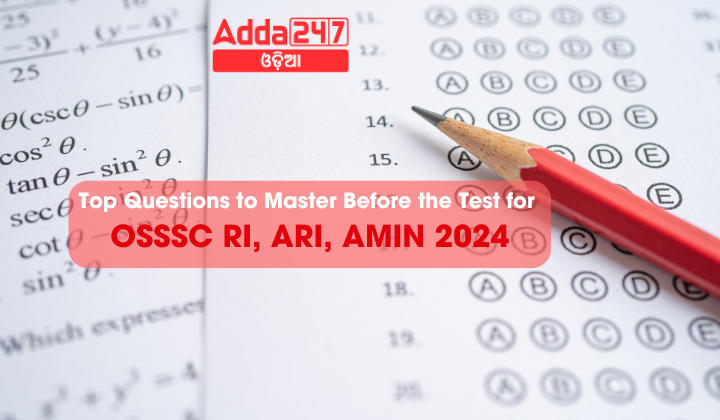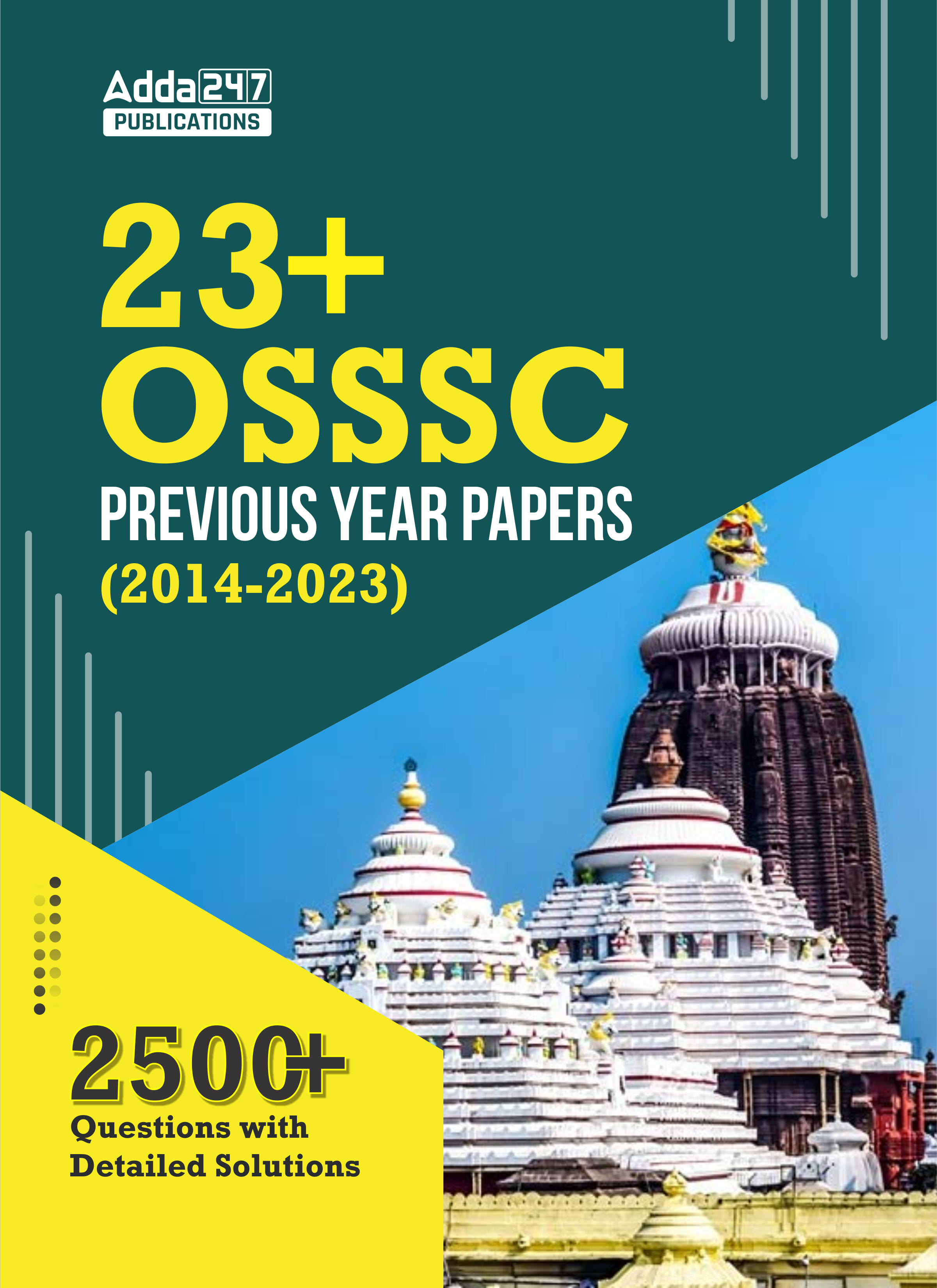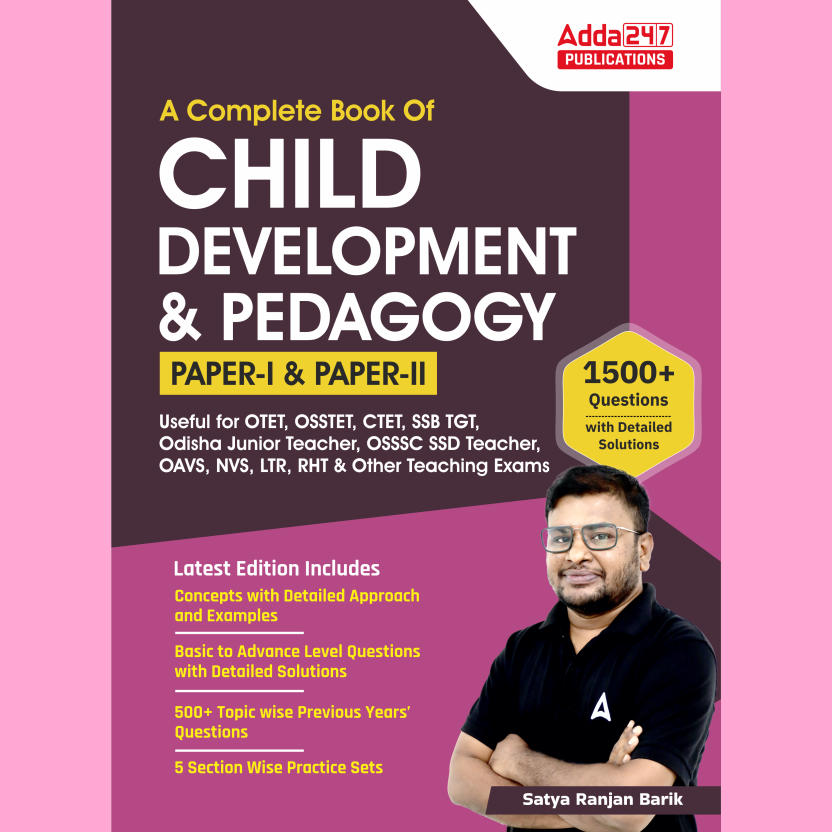The Odisha Subordinate Staff Selection Commission (OSSSC) conducts recruitment exams for various posts, such as Revenue Inspector (RI), Assistant Revenue Inspector (ARI), and AMIN. The exams assess candidates on various subjects such as General Knowledge, Mathematics, English, Odia, and Computer Skills. Preparing for these exams requires a solid understanding of key topics. To help you succeed, here are the top questions to master before the OSSSC RI, ARI, and AMIN 2024 exam.
Top Questions to Master Before the Test for OSSSC RI, ARI, AMIN 2024
- Which of the equations below doesn’t qualify the criteria of a quadratic equation?
A. (x + 2)2 = 2(x + 3)
B. x2 + 3x = (–1) (1 – 3x)2
C. (x + 2) (x – 1) = x2 – 2x – 3
D. x3 – x2 + 2x + 1 = (x + 1)3
Ans. (c) (x + 2) (x – 1) = x2 – 2x – 3
Explanation: We know that a quadratic equation has a degree of two.
By double-checking the selections,
(a) (x + 2)2 = 2(x + 3)
x2 + 4x + 4 = 2x + 6
x2 + 2x – 2 = 0
Thus, This is an example of a quadratic equation.
(b) x2 + 3x = (–1) (1 – 3x)2
x2 + 3x = -1(1 + 9×2 – 6x)
x2 + 3x + 1 + 9×2 – 6x = 0
10×2 – 3x + 1 = 0
Thus, This is an example of a quadratic equation.
(c) (x + 2) (x – 1) = x2 – 2x – 3
x2 + x – 2 = x2 – 2x – 3
x2 + x – 2 – x2 + 2x + 3 = 0
3x + 1 = 0
This is not an example of a quadratic equation. - 11th term of the A.P. -3, -1/2, 2 …. is
A. 28
B. 22
C. -38
D. -48
Ans. (b) 22
Explanation: A.P. = -3, -1/2, 2 …
First-term a = – 3
Common difference, d = a2 − a1 = (-1/2) -(-3)
⇒(-1/2) + 3 = 5/2
Nth term;
an = a+(n−1)d
a11 = 3+(11-1)(5/2)
a11 = 3+(10)(5/2)
a11 = -3+25
a11 = 22 - The following words are missing from AP: __, 13, __, 3:
A. 11 and 9
B. 17 and 9
C. 18 and 8
D. 18 and 9
Ans. (c) 18 and 8
Explanation: a2 = 13 and
a4 = 3
The nth term of an AP;
an = a+(n−1) d
a2 = a +(2-1)d
13 = a+d ………………. (i)
a4 = a+(4-1)d
3 = a+3d ………….. (ii)
When we subtract equation I from equation (ii), we obtain
– 10 = 2d
d = – 5
Fill in the value of d in equation 1 now.
13 = a+(-5)
a = 18 (first term)
a3 = 18+(3-1)(-5)
= 18+2(-5) = 18-10 = 8 (third term). - ∠B = ∠E, ∠F = ∠C and AB = 3 DE in triangles ABC and DEF. The two triangles are
A. congruent but not similar
B. similar but not congruent
C. neither similar nor congruent
D. similar as well as congruent
Ans. (b) similar but not congruent
Explanation: In ΔABC and ΔDEF,
∠B = ∠E, ∠F = ∠C and AB = 3 DE
By AA similarity criterion,
ΔABC ~ ΔDEF
AB = 3DE
⇒ AB/DE = 3
⇒ AB/DE = BC/EF = AC/DF = 3
Triangles must have a side ratio of 1 to be congruent.
Therefore, triangles are similar but not congruent. - ΔABC ~ ΔDFE, ∠A = 30°, ∠C = 50°, AB = 5 cm, AC = 8 cm and DF = 7.5 cm are provided. If that’s the case, then the following is correct:
A. DE = 12 cm, ∠ F = 50 degrees
B. DE = 12 cm, ∠ F = 100 degrees
C. ∠D = 100°, EF = 12 cm
D. ∠D = 30°, EF = 12 cm
Ans. (b) DE = 12 cm, ∠F = 100°
Explanation: Given,
ΔABC ~ ΔDFE, ∠A =30°, ∠C = 50°, AB = 5 cm, AC = 8 cm and DF= 7.5 cm
In triangle ABC,
∠A + ∠B + ∠C = 180°
∠B = 180° – 30° – 50° = 100°
The corresponding angles are equivalent because ΔABC ~ ΔDFE,
Thus, ∠D = ∠A = 30°
∠F = ∠B = 100°
∠E = ∠C = 50°
And
AB/DF = AC/DE
5/7.5 = 8/DE
DE = (8 × 7.5)/5 = 12 cm - A triangle with vertices (a, b + c), (b, c + a), and (c, a + b) has an area of :
A. (a + b + c)2
B. 0
C. a + b + c
D. ab
Ans. (b) 0
Explanation: Let the triangle’s vertices be:
A = (x1, y1) = (a, b + c)
B = (x2, y2) = (b, c + a)
C = (x3, y3) = (c, a + b)
Area of triangle ABC = (1/2)[x1(y2 – y3) + x2(y3 – y1) + x3(y1 – y2)]
= (1/2)[a(c + a – a – b) + b(a + b – b – c) + c(b + c – c – a)]
= (1/2)[a(c – b) + b(a – c) + c(b – a)]
= (1/2)[ac – ab + ab – bc + bc – ac]
= (1/2)(0)
= 0 - The expression sin6θ + cos6θ + 3 sin2θ cos2θ has a value of:-
A. 0
B. 3
C. 2
D. 1
Ans. (d) 1
Explanation: We know that, sin2θ + cos2θ = 1
Taking cube on both sides,
(sin2θ + cos2θ)3 = 1
(sin2θ)3 + (cos2θ)3 + 3 sin2θ cos2θ (sin2θ + cos2θ) = 1
sin6θ + cos6θ + 3 sin2θ cos2θ = 1 - The bucket’s two-round ends have sizes of 44 cm and 24 cm. The bucket stands 35 centimetres tall. The bucket has a capacity of
A. 32.7 litres
B. 33.7 litres
C. 34.7 litres
D. 31.7 litres
Ans. (a) 32.7 litres
Explanation: Given,
The bucket’s height is h = 35 cm.
One bucket’s circular end has a diameter of 44 cm.
The radius R = 22 cm is then calculated.
Another end’s diameter is 24 cm.
The radius r = 12 cm is then calculated.
We know that Volume of the bucket = (1/3)πh[R2 + r2 + Rr]
= (1/3) × (22/7) × 35 × [(22)2 + (12)2 + 22 × 12]
= (35/3) × (22/7) × (484 + 144 + 264)
= (5 × 22 × 892)/3
= 32706.6 cm3
= 32.7 litres. - The probability of a non-leap year with 53 Sundays being chosen at random is
A. 1/7
B. 2/7
C. 3/7
D. 5/7
Ans. (a) 1/7
Explanation: Non-leap year = 365 days
52 weeks Plus 1 day Equals 365 days
The number of Sundays in a 52-week period equals 52.
Sunday, Monday, Tuesday, Wednesday, Thursday, Friday, Saturday, and Sunday are all possible options for the last day.
The total number of possible outcomes: 7.
1 is the number of positive results.
As a result, the chance of receiving 53 Sundays is 1/7. - At what point does the perpendicular bisector of the line segment joining the points A(1,5) and B(4,6) cut the y-axis?
A. (0, 13)
B. (0, –13)
C. (0, 12)
D. (13, 0)
Ans. (a) (0, 13)
Explanation: The perpendicular bisector of line segment AB, as we know, is perpendicular at AB and goes across AB’s midpoint.
Let P be the AB’s midpoint.
Mid – point of AB = [(1 + 4)/2, (5 + 6)/2]
P = (5/2, 11/2)
The line AB’s slope = (6 – 5)/(4 – 1) = 1/3 is now calculated.
As a result, the bisector’s slope = -1/slope of line AB = -1/(1/3) = -3.
Using the point-slope form, the equation for the line passing through the point P(5/2, 11/2) with slope -3 is:
y – (11/2) = -3[x – (5/2)]
(2y – 11)/2 = -3[(2x – 5)/2]
2y – 11 = -6x + 15
2y = -6x + 15 + 11
2y = -6x + 26
y = -3x + 13
The formula is y = mx + c.
The y-intercept is c = 13 in this case.
As a result, the y-axis is cut at A(1, 5) by the perpendicular bisector of the line segment linking the points A(1, 5) and B(4, 6). (0, 13). - Look at this series: 2, 1, (1/2), (1/4), … What number should come next?
A. (1/3)
B. (1/8)
C. (2/8)
D. (1/16)
Answer: B. (1/8)
Explanation:
4/2 = 2
2/2 = 1
1/2 = 1/2
(1/2)/2 = 1/4
(1/4)/2 = 1/8 and so on.Look at this series: 7, 10, 8, 11, 9, 12, … What number should come next?
A. 7
B. 10
C. 12
D. 13
Answer: D. 13
Explanation:
This is a simple alternating addition and subtraction series. In the first pattern, 3 is added; in the second, 2 is subtracted. - Look at this series: 36, 34, 30, 28, 24, … What number should come next?
A. 20
B. 22
C. 23
D. 26
Answer: B. 22
Explanation:
This is an alternating number subtraction series. First, 2 is subtracted, then 4, then 2, and so on. - Look at this series: 22, 21, 23, 22, 24, 23, … What number should come next?
A. 22
B. 24
C. 25
D. 26
Answer: C. 25
Explanation:
In this simple alternating subtraction and addition series; 1 is subtracted, then 2 is added, and so on. - Look at this series: 53, 53, 40, 40, 27, 27, … What number should come next?
A. 12
B. 14
C. 27
D. 53
Answer: A. 12
Explanation:
In this series, each number is repeated, then 13 is subtracted to arrive at the next number. - Look at this series: SCD, TEF, UGH, ____, WKL
A. CMN
B. UJI
C. VIJ
D. IJT
Answer: C. VIJ
Explanation:
There are two alphabetical series here. The first series is with the first letters only: S, T, U, V, W. The second series involves the remaining letters: CD, EF, GH, IJ, KL. - Look at this series: B2CD, _____, BCD4, B5CD, BC6D
A. B2C2D
B. BC3D
C. B2C3D
D. BCD7
Answer: B. BC3D
Explanation:
Because the letters are the same, concentrate on the number series, which is a simple 2, 3, 4, 5, 6 series, and follows each letter in order. - Look at this series: FAG, GAF, HAI, IAH, ____
A. JAK
B. HAL
C. HAK
D. JAI
Answer: A. JAK
Explanation:
The middle letters are static, so concentrate on the first and third letters. The series involves an alphabetical order with a reversal of the letters. The first letters are in alphabetical order: F, G, H, I, J. The second and fourth segments are reversals of the first and third segments. - Look at this series: ELFA, GLHA, ILJA, _____, MLNA
A. OLPA
B. KLMA
C. LLMA
D. KLLA
Answer: B. KLMA
Explanation:
The second and fourth letters in the series, L and A, are static. The first and third letters consist of an alphabetical order beginning with the letter E. - Look at this series: CMM, EOO, GQQ, _____, KUU
A. GRR
B. GSS
C. ISS
D. ITT
Answer: C. ISS
Explanation:
The first letters are in alphabetical order with a letter skipped in between each segment: C, E, G, I, K. The second and third letters are repeated; they are also in order with a skipped letter: M, O, Q, S, U. - Which word does NOT belong with the others?
A. Parsley
B. Basil
C. Dill
D. Mayonnaise
Answer: D
Explanation: Parsley, basil, and dill are types of herbs. Mayonnaise is not an herb. - Which state in India is known for its Sonepur Mela, the largest animal fair?
(a) Bihar
(b) Rajasthan
(c) Uttar Pradesh
(d) Gujarat
Ans: (a) Bihar - Which is the highest dam in India?
(a) Bhakra Dam
(b) Sardar Sarovar Dam
(c) Tehri Dam
(d) Hirakud Dam
Ans: (c) Tehri Dam - Wular Lake, the largest lake in India, is located in which state/union territory?
(a) Kerala
(b) Jammu & Kashmir
(c) West Bengal
(d) Assam
Ans: (b) Jammu & Kashmir - The largest cave temple in India is the Kailashnath Temple. Where is it located?
(a) Maharashtra
(b) Tamil Nadu
(c) Karnataka
(d) Madhya Pradesh
Ans: (a) Maharashtra - Kangchenjunga, the highest peak in India, is located in which state?
(a) Himachal Pradesh
(b) Uttarakhand
(c) Sikkim
(d) Arunachal Pradesh
Ans: (c) Sikkim - Jama Masjid, the largest mosque in India, is located in which city?
(a) Lucknow
(b) Hyderabad
(c) Delhi
(d) Mumbai
Ans: (c) Delhi - The largest delta in the world, Sundarbans, is located in which state?
(a) Odisha
(b) West Bengal
(c) Andhra Pradesh
(d) Tamil Nadu
Ans: (b) West Bengal - The longest railway tunnel in India, Pir Panjal Tunnel, is located in which state/union territory?
(a) Himachal Pradesh
(b) Uttarakhand
(c) Jammu & Kashmir
(d) Punjab
Ans: (c) Jammu & Kashmir - What is the name of the longest sea bridge in India?
(a) Bandra-Worli Sea Link
(b) Pamban Bridge
(c) Atal Setu (Mumbai Trans Harbour Link)
(d) Mahatma Gandhi Setu
Ans: (c) Atal Setu (Mumbai Trans Harbour Link) - Chhatrapati Shivaji International Airport is located in which city?
(a) Delhi
(b) Bangalore
(c) Mumbai
(d) Kolkata
Ans: (c) Mumbai - “ବାଡ଼ି ବାଡ଼ି ଦ୍ଵାରା ଯୁଦ୍ଧ” – ଗୋଟିଏ ପଦରେ ପ୍ରକାଶ କର?
(a) ବାଡାବାଡି
(b) ନିଘଞ୍ଚ
(c) ଅତ୍ୟୁକ୍ତି
(d) ଅଧ୍ୟାପକ
Ans: (a) ବାଡାବାଡି - “ବଜ୍ରପରି କଠୋର” – ଗୋଟିଏ ପଦରେ ପ୍ରକାଶ କର?
(a) ବଜ୍ରକଠୋର
(b) ନିଘଞ୍ଚ
(c) ଅତ୍ୟୁକ୍ତି
(d) ଅଧ୍ୟାପକ
Ans: (a) ବଜ୍ରକଠୋର - “ବନର ପତି” – ଗୋଟିଏ ପଦରେ ପ୍ରକାଶ କର?
(a) ବନସ୍ପତି
(b) ନିଘଞ୍ଚ
(c) ଅତ୍ୟୁକ୍ତି
(d) ଅଧ୍ୟାପକ
Ans: (a) ବନସ୍ପତି - “ବଣରୁ ଜାତ” – ଗୋଟିଏ ପଦରେ ପ୍ରକାଶ କର?
(a) ବଣ୍ୟ
(b) ନିଘଞ୍ଚ
(c) ଅତ୍ୟୁକ୍ତି
(d) ଅଧ୍ୟାପକ
Ans: (a) ବଣ୍ୟ - ଗୁଣାକାରର ସନ୍ଧି ବିଚ୍ଛେଦ କଣ?
(a) ଗୁଣ + ଆକର
(b) ଗୁଣା + ଆକର
(c) ଗୁଣ + କାର
(d) ଗୁଣା + କାର
Ans: (a) ଗୁଣ + ଆକର - ଉଚ୍ଚାସନର ସନ୍ଧି ବିଚ୍ଛେଦ କଣ?
(a) ଉଚ୍ଚ + ଆସନ
(b) ଉଚ୍ଚା + ଆସନ
(c) ଉଚ୍ଚ + ସନ
(d) ଉଚ୍ଚା + ସନ
Ans: (a) ଉଚ୍ଚ + ଆସନ - ଧ୍ବନି ମାନଙ୍କର ଲିଖୂତ ରୂପ କଣ ?
(a) ଭାଷା
(b) ବର୍ଣ୍ଣ
(c) ଧ୍ୱନି
(d) ଶବ୍ଦ
Ans: (b) ବର୍ଣ୍ଣ - କ ବର୍ଗ ର ଅନ୍ୟ ନାମ କଣ ?
(a) କଣ୍ଠ ବର୍ଣ୍ଣ
B ତାଲବ୍ଯ ବର୍ଣ୍ଣ
C ଓଷ୍ଠ ବର୍ଣ୍ଣ
D ଦନ୍ଧ୍ୟ ବର୍ଣ୍ଣ
Ans: (a) କଣ୍ଠ ବର୍ଣ୍ଣ - ସମାସ ବାକ୍ୟ ନଥାଇ ସମାସ ହେଲେ ତାକୁ କି ସମାସ କହନ୍ତି ?
(a) ବହୁବ୍ରୀହି
(b) ଦ୍ବିଗୁ
(c) ନିତ୍ୟ
(d) ନଞ୍ଜ ତତ୍ପୁରୁଷ
Ans:(c) ନିତ୍ୟ - ଅବ୍ୟୟପଦ ପୂର୍ବପଦ ରୂପେ ରହି ଅନ୍ୟୁପଦ ସହିତ ସମାନ ହେଲେ ଓ ଅବ୍ୟୟ ପଦର ପ୍ରାଧାନ୍ୟ ଥିଲେ ଯେଉଁ ସମାସ ହୁଏ ତାକୁ କ’ଣ କହନ୍ତି |
(a) ବହୁବ୍ରୀହି
(b) ଦ୍ବନ୍ଦ୍ବ
(c) ଅବ୍ୟୟୀଭାବ
(d) ତତପୁରୁଷ
Ans: (c) ଅବ୍ୟୟୀଭାବ - I enjoy ________ tennis.
(A) to play
(B) plays
(C) playing
(D) to playing
Ans: (C) playing - Most of the guests arrived ________ buses.
(A) with
(B) by
(C) from
(D) in
Ans: (D) in - The departmental store is open ________ eight to seven.
(A) by
(B) from
(C) between
(D) during
Ans: (B) from - On leaving the shopping plaza, Kate was robbed ________ purse.
(A) by her
(B) by hers
(C) of her
(D) of hers
Ans: (C) of her - If I had money, I ________ it now.
(A) will purchase
(B) would purchase
(C) would have purchased
(D) have purchased
Ans: (B) would purchase - The man ________ you met is an anchorperson.
(A) who
(B) whose
(C) whom
(D) which
Ans: (C) whom - The woman ________ is standing by the table works in electronic media.
(A) who
(B) whose
(C) whom
(D) which
Ans: (A) who - He is looking for accommodation ________ in flat or shared house.
(A) both
(B) until
(C) neither
(D) either
Ans: (D) either - You can go neither by train ________ by bus.
(A) no
(B) nor
(C) or
(D) and
Ans: (B) nor - Before designing a public park, the architect must ________ the public.
(A) consider
(B) considers
(C) recognize
(D) recognizes
Ans: (A) consider
















